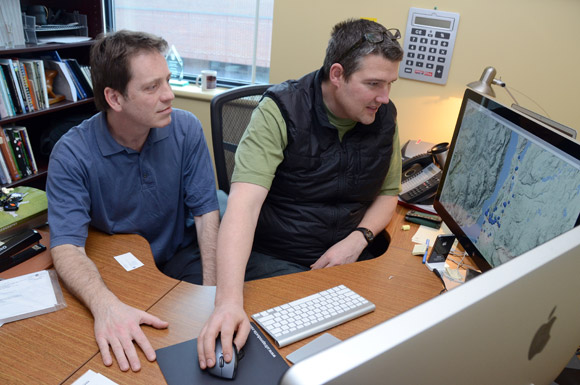
Human geography student Shayne Wright, left, and Jon Corbett, assistant professor of Community, Culture and Global Studies, check out some of the comments at a food mapping website they developed.
Narrative map concept born on UBC’s Okanagan campus
A stroll through just about any grocery store shows just how much our food supply has gone international.
Human geography student Shayne Wright and Jon Corbett, assistant professor of Community, Culture and Global Studies at UBC’s Okanagan campus believe people not only want to think about where their food comes from, but will want to share foodie thoughts and actively discuss their interests through a specially designed website they have created.
“We can all agree food has become globalized. Even here in the Okanagan where we produce so much,” says Wright who wanted to develop his thesis on mapping out food sources to be interactive with the public.
So together with Corbett, a unique mapping idea was born.
“We came up with the idea of a narrative map,” says Corbett. “It’s like an instant-messaging map.”
The mapping is being done in partnership with the Central Okanagan Food Policy Council and the Interior Health Authority and is funded by UBC’s Institute for Healthy Living and Chronic Disease Prevention and the Geomatics for Informed Decisions (GEOIDE) network.
People can post comments on the map about food sources, problems and successes and even engage in online discussions about a specific place.
“You have this whole dialogue taking place,” says Corbett. “It acts as a starting point for people to think more critically about food. It becomes an active dialogue between people.”
Wright says it has been enlightening to learn about other people’s views on food issues in the Valley.
“Most people never knew what other people thought,” says Wright. “They get to compare their own views with other people. It’s that sharing of views that has been interesting.”
Groups like Interior Health are taking a keen interest in the mapping to better understand and promote a healthy diet. The discussions are generated from numerous spots throughout the Central Okanagan.
Wright says information gathered will be passed along to a variety of groups such as Sustainable Communities, professors, students, consulting companies and any agency that has a role to play.
The mapping program itself is also getting attention. Corbett says site mapping is nothing new, but the added dimension of being able to comment and carry on a dialogue is.
Corbett and Wright designed the program from the ground up and it is sparking interest with a variety of groups who are interested in applying it in their own fields. Project co-investigator Casey Hamilton and UBC web-based participatory mapping application (GEOLIVE) programmer Nick Blackwell were also instrumental in making the mapping possible.
To get in on the conversation, go to www.communityfood.ca.
To contribute to conversation participants must register, but anyone can click on the icon to see what is being said.
— 30 —